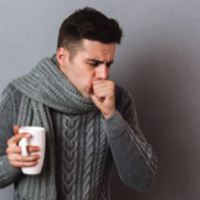Non-pharmacological remedies for post-viral acute cough

Submitted: February 25, 2021
Accepted: June 13, 2021
Published: August 10, 2021
Accepted: June 13, 2021
Abstract Views: 8194
PDF: 3737
Publisher's note
All claims expressed in this article are solely those of the authors and do not necessarily represent those of their affiliated organizations, or those of the publisher, the editors and the reviewers. Any product that may be evaluated in this article or claim that may be made by its manufacturer is not guaranteed or endorsed by the publisher.
All claims expressed in this article are solely those of the authors and do not necessarily represent those of their affiliated organizations, or those of the publisher, the editors and the reviewers. Any product that may be evaluated in this article or claim that may be made by its manufacturer is not guaranteed or endorsed by the publisher.
Similar Articles
- Silvia Faverzani, Filippo Nocera, Ernesto Crisafulli, Maurizio Marvisi, Andrea Becciolini, Federica Mosetti, Eleonora Di Donato, Flavio Mozzani, Daniele Santilli, Giuseppe Scopelliti, Alarico Ariani, Home-based unsupervised pulmonary rehabilitation program improves the respiratory disability in systemic sclerosis patients with dyspnea: an observational prospective study , Monaldi Archives for Chest Disease: Vol. 92 No. 3 (2022)
- Morgan Daniel, Charles Ricordel, Aurélien Lorleac'h, James Norwood, Bertrand Richard De Latour, Simon Rouzé, Jean-Philippe Verhoye, The illusion of a chest wall tumor: a case-report of sternal tuberculosis , Monaldi Archives for Chest Disease: Vol. 92 No. 4 (2022)
- Angelica Cersosimo, Giuliana Cimino, Ludovica Amore, Emiliano Calvi, Greta Pascariello, Riccardo Maria Inciardi, Carlo Mario Lombardi, Enrico Vizzardi, Marco Metra, Cardiac biomarkers and mortality in COVID-19 infection: A review , Monaldi Archives for Chest Disease: Vol. 93 No. 1 (2023)
- Elpida Skouvaklidou, Ioannis Neofytou, Maria Kipourou, Konstantinos Katsoulis, Persistent unilateral diaphragmatic paralysis in the course of Coronavirus Disease 2019 pneumonia: a case report , Monaldi Archives for Chest Disease: Vol. 93 No. 4 (2023)
- Firas Aljanadi, Jonathan Strickland, Liana Montgomery, Mark Jones, Review of patients discharged post thoracic surgery with chest drain in situ and nurse-based follow-up clinic , Monaldi Archives for Chest Disease: Vol. 94 No. 2 (2024)
- Salvatore Andrea Sciurello, Francesca Graziano, Maria Marcella Laganà, Elena Compalati, Gabriele Pappacoda, Simone Gambazza, Jorge Navarro, Pietro Cecconi, Francesca Baglio, Paolo Banfi, Feasibility of high-frequency percussions in people with severe acquired brain injury and tracheostomy: an observational study , Monaldi Archives for Chest Disease: Early Access
- Anna Jacob, Kranti Garg, Kashish Dutta, Varinder Saini, Deepak Aggarwal, Ajeet Sidana, Role of detailed psychological evaluation and treatment in pulmonary rehabilitation programs for patients with chronic obstructive pulmonary disease , Monaldi Archives for Chest Disease: Early Access
- Federico Raimondi, Stefano Centanni, Fabrizio Luppi, Stefano Aliberti, Francesco Blasi, Paola Rogliani, Claudio Micheletto, Marco Contoli, Alessandro Sanduzzi Zamparelli, Marialuisa Bocchino, Paolo Busatto, Luca Novelli, Simone Pappacena, Luca Malandrino, Giorgio Lorini, Greta Cairoli, Fabiano Di Marco, Respiratory rate-oxygenation index on the 3rd day is the best predictor of treatment failure in COVID-19 patients , Monaldi Archives for Chest Disease: Early Access
- Biswajit Maharana , Pallab Chakraborty, Sudhan Rackimuthu , Rusab Baig, Shreeji Kadakia, Paradoxical role of oxygen in the treatment of patients with COVID-19 , Monaldi Archives for Chest Disease: Vol. 92 No. 2 (2022)
- Nedia Moussa , Rahma Gargouri, Mouna Snoussi, Rym Khemakhem, Zouhir Bahloul, Samy Kammoun, Nonspecific interstitial pneumonia revealing an antisynthetase syndrome , Monaldi Archives for Chest Disease: Vol. 93 No. 3 (2023)
<< < 33 34 35 36 37 38 39 40 41 42 > >>
You may also start an advanced similarity search for this article.

 https://doi.org/10.4081/monaldi.2021.1821
https://doi.org/10.4081/monaldi.2021.1821





